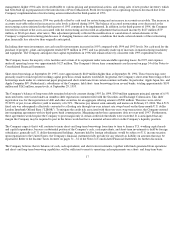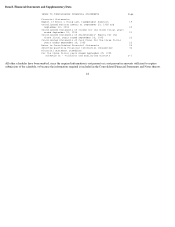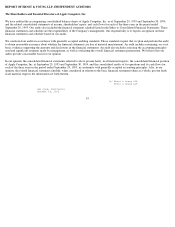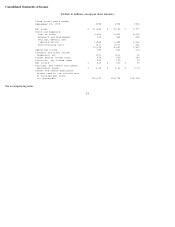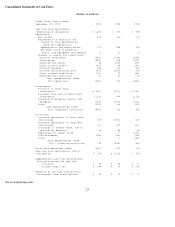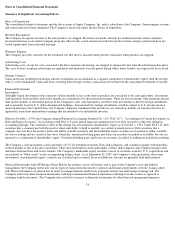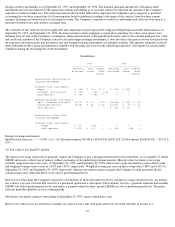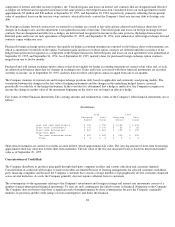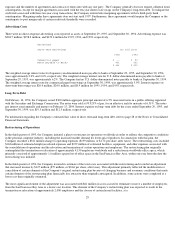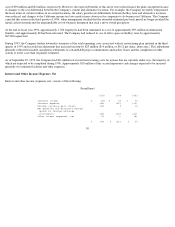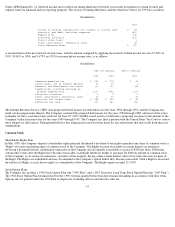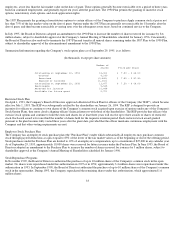Apple 1995 Annual Report Download - page 26
Download and view the complete annual report
Please find page 26 of the 1995 Apple annual report below. You can navigate through the pages in the report by either clicking on the pages listed below, or by using the keyword search tool below to find specific information within the annual report.Notes to Consolidated Financial Statements
Summary of Significant Accounting Policies
Basis of Presentation
The consolidated financial statements include the accounts of Apple Computer, Inc. and its subsidiaries (the Company). Intercompany accounts
and transactions have been eliminated. The Company's fiscal year-end is the last Friday in September.
Revenue Recognition
The Company recognizes revenue at the time products are shipped. Provisions are made currently for estimated product returns and price
protection that may occur under Company programs. Historically, actual amounts recorded for product returns and price protection have not
varied significantly from estimated amounts.
Warranty Expense
The Company provides currently for the estimated cost that may be incurred under product warranties when products are shipped.
Advertising Costs
Advertising costs, except for costs associated with direct-response advertising, are charged to expense the first time the advertising takes place.
The costs of direct-response advertising are capitalized and amortized over the period during which future benefits are expected to be received.
Foreign Currency
Gains and losses resulting from foreign currency translation are accumulated as a separate component of shareholders' equity until the foreign
entity is sold or liquidated. Gains and losses resulting from foreign currency transactions are included in the consolidated statement of income.
Financial Instruments
Investments
All highly liquid investments with a maturity of three months or less at the date of purchase are considered to be cash equivalents; investments
with maturities between three and twelve months are considered to be short-term investments. There are no investments with maturities greater
than twelve months. A substantial portion of the Company's cash, cash equivalents, and short-term investments is held by foreign subsidiaries
and is generally based in U.S. dollar-denominated holdings. Amounts held by foreign subsidiaries would be subject to U.S. income taxation
upon repatriation to the United States; the Company's financial statements fully provide for any related tax liability on amounts that may be
repatriated, aside from undistributed earnings that are intended to be indefinitely invested.
Effective October 1, 1994, the Company adopted Financial Accounting Standard No. 115 ("FAS 115"), "Accounting for Certain Investments in
Debt and Equity Securities." In accordance with FAS 115, prior period financial statements have not been restated to reflect the change in
accounting principle. The cumulative effect of the change was not material to shareholders' equity as of October 1, 1994. Under FAS 115, debt
securities that a company has both the positive intent and ability to hold to maturity are carried at amortized cost. Debt securities that a
company does not have the positive intent and ability to hold to maturity and all marketable equity securities are classified as either available-
for-sale or trading and are carried at fair value. Generally, unrealized holding gains and losses on securities classified as available- for-sale are
reported as a component of shareholders' equity. Unrealized holding gains and losses on securities classified as trading are included in earnings.
The Company's cash equivalents consist primarily of U.S. Government securities, Euro-dollar deposits, and commercial paper with maturities
of three months or less at the date of purchase. Short-term investments consist principally of Euro-dollar deposits and commercial paper with
maturities between three and twelve months. The Company's marketable equity securities consist of securities issued by U.S. corporations and
are included in "Other assets" on the accompanying balance sheet. As of September 29, 1995, the Company's cash equivalents, short-term
investments, and marketable equity securities are classified and accounted for as available-for-sale and are generally held until maturity.
Financial Instruments with Off-Balance-Sheet Risk In the ordinary course of business and as part of the Company's asset and liability
management, the Company enters into various types of transactions that involve contracts and financial instruments with off- balance-sheet
risk. These instruments are entered into in order to manage financial market risk, primarily interest rate and foreign exchange risk. The
Company enters into these financial instruments with major international financial institutions utilizing over-the-counter as opposed to
exchange traded instruments. The Company does not hold or transact in financial instruments for other than risk management purposes.
24





